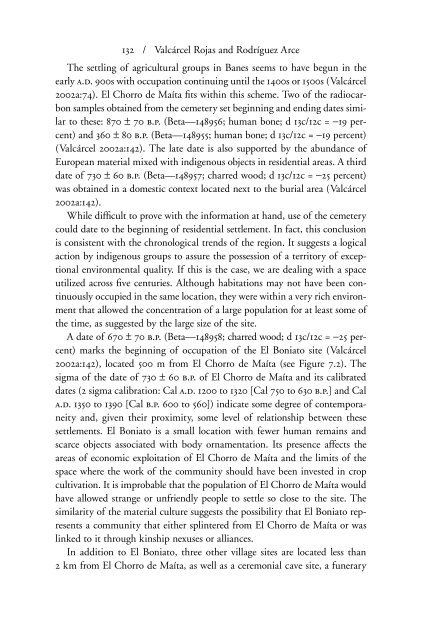Dialogues in Cuban Archaeology
by L. Antonio Curet, Shannon Lee Dawdy, and Gabino La Rosa Corzo
by L. Antonio Curet, Shannon Lee Dawdy, and Gabino La Rosa Corzo
Create successful ePaper yourself
Turn your PDF publications into a flip-book with our unique Google optimized e-Paper software.
132 / Valcárcel Rojas and Rodríguez Arce<br />
The settl<strong>in</strong>g of agricultural groups <strong>in</strong> Banes seems to have begun <strong>in</strong> the<br />
early a.d. 900s with occupation cont<strong>in</strong>u<strong>in</strong>g until the 1400s or 1500s (Valcárcel<br />
2002a:74). El Chorro de Maíta ¤ts with<strong>in</strong> this scheme. Two of the radiocarbon<br />
samples obta<strong>in</strong>ed from the cemetery set beg<strong>in</strong>n<strong>in</strong>g and end<strong>in</strong>g dates similar<br />
to these: 870 ± 70 b.p. (Beta—148956; human bone; d 13c/12c = −19 percent)<br />
and 360 ± 80 b.p. (Beta—148955; human bone; d 13c/12c = −19 percent)<br />
(Valcárcel 2002a:142). The late date is also supported by the abundance of<br />
European material mixed with <strong>in</strong>digenous objects <strong>in</strong> residential areas. A third<br />
date of 730 ± 60 b.p. (Beta—148957; charred wood; d 13c/12c = −25 percent)<br />
was obta<strong>in</strong>ed <strong>in</strong> a domestic context located next to the burial area (Valcárcel<br />
2002a:142).<br />
While dif¤cult to prove with the <strong>in</strong>formation at hand, use of the cemetery<br />
could date to the beg<strong>in</strong>n<strong>in</strong>g of residential settlement. In fact, this conclusion<br />
is consistent with the chronological trends of the region. It suggests a logical<br />
action by <strong>in</strong>digenous groups to assure the possession of a territory of exceptional<br />
environmental quality. If this is the case, we are deal<strong>in</strong>g with a space<br />
utilized across ¤ve centuries. Although habitations may not have been cont<strong>in</strong>uously<br />
occupied <strong>in</strong> the same location, they were with<strong>in</strong> a very rich environment<br />
that allowed the concentration of a large population for at least some of<br />
the time, as suggested by the large size of the site.<br />
A date of 670 ± 70 b.p. (Beta—148958; charred wood; d 13c/12c = −25 percent)<br />
marks the beg<strong>in</strong>n<strong>in</strong>g of occupation of the El Boniato site (Valcárcel<br />
2002a:142), located 500 m from El Chorro de Maíta (see Figure 7.2). The<br />
sigma of the date of 730 ± 60 b.p. of El Chorro de Maíta and its calibrated<br />
dates (2 sigma calibration: Cal a.d. 1200 to 1320 [Cal 750 to 630 b.p.] and Cal<br />
a.d. 1350 to 1390 [Cal b.p. 600 to 560]) <strong>in</strong>dicate some degree of contemporaneity<br />
and, given their proximity, some level of relationship between these<br />
settlements. El Boniato is a small location with fewer human rema<strong>in</strong>s and<br />
scarce objects associated with body ornamentation. Its presence affects the<br />
areas of economic exploitation of El Chorro de Maíta and the limits of the<br />
space where the work of the community should have been <strong>in</strong>vested <strong>in</strong> crop<br />
cultivation. It is improbable that the population of El Chorro de Maíta would<br />
have allowed strange or unfriendly people to settle so close to the site. The<br />
similarity of the material culture suggests the possibility that El Boniato represents<br />
a community that either spl<strong>in</strong>tered from El Chorro de Maíta or was<br />
l<strong>in</strong>ked to it through k<strong>in</strong>ship nexuses or alliances.<br />
In addition to El Boniato, three other village sites are located less than<br />
2 km from El Chorro de Maíta, as well as a ceremonial cave site, a funerary


















